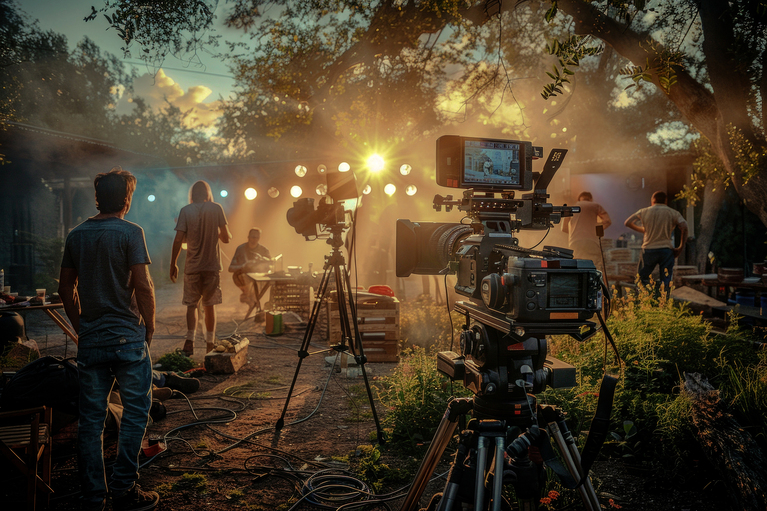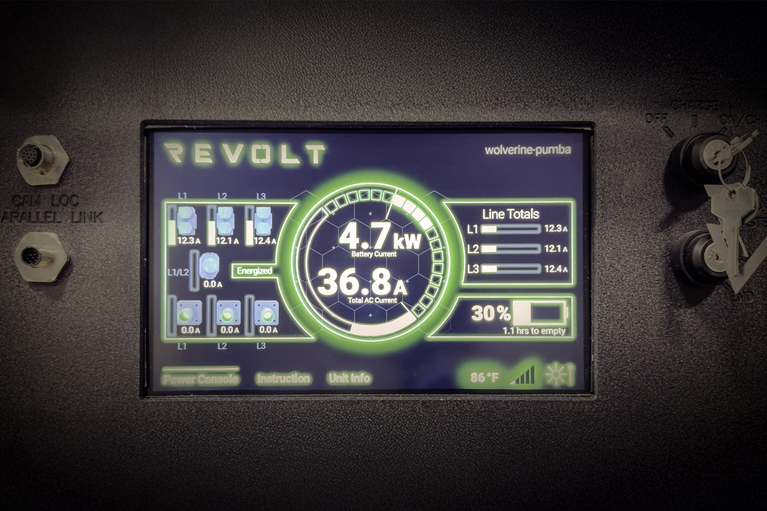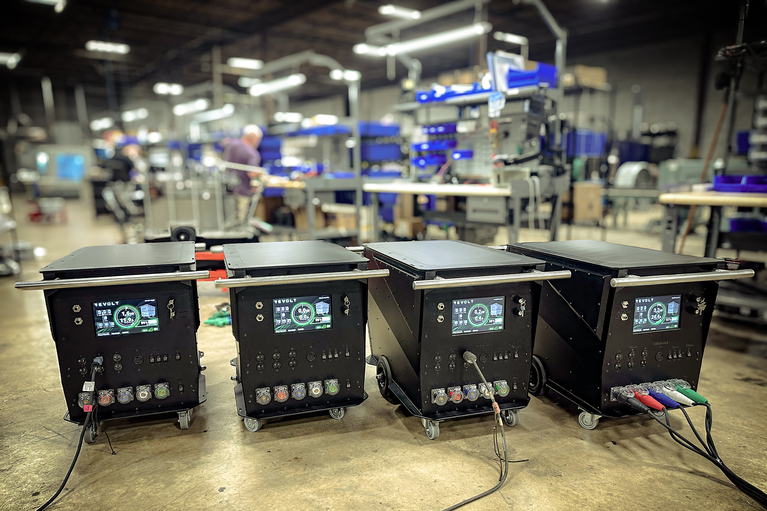
ReVolt – Technical Q&A
ReVolt is cleaning up Hollywood's emission problems today and next will address construction sites, emergency response and events with portable DC power
Digital Electricity™ technology allows unparalleled construction, performance and safety advantages over any alternative power method.
Podcast with Luke Getto, Voltserver’s director of product management and host, Jason Lomberg at Power Systems Design
LOMBERG: Welcome to the PSDcast with your host, Jason Lomberg at Power Systems Design. It’s not often that we come across a technology or a concept that could reinvent the very way electricity is distributed, but that’s exactly what the good folks at Voltserver™ are promising with their digital electricity method. According to the company, digital electricity offers the convenience and safety of low-voltage power over Ethernet with the power over distance capabilities of AC, and it offers unparalleled construction, performance, and safety advantages over any alternative power method. So needless to say, I’m intrigued. Here to explain more is Luke Getto, who’s Voltserver’s director of product management. Luke, thanks for joining us, and maybe you could start by telling us why digital electricity is so necessary today.
GETTO: Hi. Thank you for having me on your show. Glad to be here. Let’s first just think about why – why digital electricity exists. If you look around your home or your office, how do you power something, whether it’s your computer or your vacuum? Probably looking at your outlet – nice, convenient gang box. You’ve got a couple outlets, two or four there. Standard NEMA 5-15 connectors, right? They offer pretty much limitless power. You can plug so many things into that outlet before the breaker trips. Everybody’s had maybe a dryer and a heater or a hairdryer that maybe trips your breaker, but it’s lot of power before you do that, right?
Well, those outlets can be deadly to you and your family. If you have little kids like me, you probably have those little plastic plug covers that break your fingernails when you try to pull them off. Or maybe you have something easier to use, but it was more expensive. But if you think about – if a stroller injures a baby, what happens? The manufacturer recalls it, fixes the issue, sends out new models. When a car has a defect that can cause harm – manufacturer recall, right? If you or your family members stick their finger into an electrical outlet, at a minimum, it’s going to hurt. But you could even die. There could be resistive faults that burn down your house – God forbid, with anyone inside it. Why do we still accept that as normal? Why is that acceptable at all in today’s society?
I’m very handy around the house. I’m also an electrical engineer by education. But I will not touch the electrical wiring in my house. I’m too afraid of being shocked or doing it wrong and causing a fire. So that’s where the idea originated. How do we make electrical power safer? How do we make it better? The world is pretty familiar with power over Ethernet at this point and AC. But you’ve got this dynamic of basically high power and low power. As I mentioned before, you’ve got a ton of power over your outlet, but it’s dangerous. Power over Ethernet – it’s much safer. It’s a lower voltage. It’s a limited power supply. They call it Class 2 wiring methods. You could wire that just like you’re doing your Ethernet cords between your computer and your router. But it’s got a limited power. It’s only up to 100 watts, which is at the output of your POE switch. So it’s got a limited power and a limited distance. Digital electricity really fills the gap between those. It can offer a significant amount of power at a significant distance, even up to two kilometers, about 6,500 feet, with the power equivalency of an AC outlet.
LOMBERG: Right. Now, in all the PR I saw for this, one of the key words that keeps popping up is safety. You mentioned this already, but maybe you could underline it. So how and why is digital electricity such a safe solution?
GETTO: Sure. So the CEO, Steve Eaves, who founded the company, he likes to compare a high-pressure stream of water to raindrops. If you were to get hit with a high-pressure stream of water from a fire hose, it would hurt. It’d be dangerous. But if you stand outside in the rain, you’re going to get wet, but you’re not going to get injured.
So what we’re doing on the electrical side is a technology we call packet energy transfer. To simplify it, we’re basically creating a square wave at around 350 volts, which sounds like a lot of voltage. What we do is we pulse that wave. So it comes on. It sends a packet of energy. And then it turns off. In that turnoff period, we do a safety check. The safety check determines if there is a short circuit, there’s an open circuit, or there’s some other fault on the line – someone touching it, resistive fault, things like that. If the safety check passes, it sends another pulse. If it passes, it sends another pulse. If it fails, it stops, and there’s no more pulses sent. That occurs in less than 10 milliseconds. So the actual energy dissipated into a fault is very, very small. It’s probably only about one joule from one of those packets.
LOMBERG: Interesting. Now, one of the other critical concepts for our modern world that everybody’s heard a lot about, especially as we move away from fossil fuels to renewable energy, is energy efficiency. So could you explain how digital electricity is more energy-efficient than the status quo and competing solutions?
GETTO: Sure. Let me just say that we’re not changing physics. We’re not creating some magical new electricity that is more efficient than everything else. We’re not breaking Ohm’s law or anything like that. But there are a few ways that digital electricity can be more efficient.
First, the higher voltage that’s sent along the wires – the higher the voltage, the lower the current. So according to Ohm’s law, the higher the current that you send through a resistive device, which is a wire, the more loss. So when you lower the current by increasing the voltage, you get less loss in the wires. Right there, you have a little bit of a benefit.
We’re also enabling a DC building. You may have heard of this concept where most of our end devices, the powered loads – your laptop, your phone, other things like that – they’re really DC-powered. That’s why you’ve got these wall warts that plug into the wall, and then you’ve got a USB cable that goes into your devices. It’s an AC-to-DC adapter. Each of those adapters is at best probably about 90% to 95% efficient. So you’re losing 5%, 10%, 15%, or even 20% of your energy at every single device that is plugged into the wall. If you can have a DC-powered infrastructure, you can send DC out to all of your devices, and a DC-DC converter which takes one voltage to another is more efficient than an AC-to-DC converter. So you’re saving a few percent at every single device by removing those conversions.
This can be enhanced when you use a DC micro grid from renewable energy. A solar panel natively has a DC output. So when you have a solar array on your roof of a building or your home, it’s DC, and it goes into an inverter. That inverter converts it to AC, which then is married with the AC mains from the grid so that your house is all AC as it is. But again, that inverter which is taking DC to AC is inefficient. It may be pretty close to 100% – maybe 95% or so – but you’re still losing a few percent of that energy. If you think about a large commercial office building, a few percent conversion loss can be very, very significant.
So then the final piece that allows us to be energy-efficient is the native controls. This is a digital platform, and we are monitoring all the connections to all the devices. If we need to shut them off, we can. We can create power policies that say at night, we’re going turn off the lights, or we’re going to do something else – turn down the power here, turn up the power there. So having the control and the intelligence around what is being powered – just being able to turn it off at night can save energy.
LOMBERG: Interesting. Luke, before I let you go, what do you think it’ll take for digital electricity to become the predominant way to distribute power? Is it inevitable, or will it take federal or some kind of industry intervention?
GETTO: Well, we certainly hope that one day, the world will be powered with digital electricity. I will let you know that there is some code under discussion by the NEC. It’s called Class 4, fault-managed power. So pretty much today, we have Class 1, which is your AC outlets, Class 2, which is your power over Ethernet, and then Class 4 is something being discussed for the next code release. Essentially, it pretty much describes a digital electricity approach where you can deliver more energy than power over Ethernet, which is really only limited because the amount of power transmitted cannot hurt somebody. Fault-managed power says you can deliver more power as long as you are able to turn it off in a time that prevents injury. We’re working closely with those standards bodies and many other players in the industry, and we’re pretty confident that this is going to become a reality. So we’re going to see other options out there for a fault-managed power system, and I think that’s just going to open up the ecosystem to everybody and make the energy distribution safer and more intelligent in the world.
LOMBERG: Excellent. We certainly hope so. Thanks, Luke. On behalf of PSD, I want to thank you for your time. nd to our audience, thanks for tuning in.
This podcast was originally published by Power System Design.
ReVolt – Technical Q&A
ReVolt is cleaning up Hollywood's emission problems today and next will address construction sites, emergency response and events with portable DC power
How ReVolt leverages Vicor technology for carbon-neutral film production
Vicor’s power converters to provide clean, mobile, and always-on electricity
Helping Hollywood fulfill its green ambitions
ReVolt is the cleaner, greener solution to the massive fossil fuel burning generators used on movie sets today. Learn how Vicor is helping ReVolt
16th Asia Power Technology Development Forum 2025
Vicor presented high-density DC–DC power modules maximize ATE throughput



